What Is IPv6 Enhanced?
IPv6 Enhanced uses the ultra-large address space of IPv6 and involves protocol innovations such as Segment Routing over IPv6 (SRv6), network slicing, In-situ Flow Information Telemetry (IFIT), and Bit Index Explicit Replication IPv6 Encapsulation (BIERv6), as well as technical innovations such as network analysis and automatic optimization. IPv6 Enhanced comprehensively improves IP network capabilities in terms of intelligence, security, ultra-high bandwidth, ubiquitous connectivity, deterministic quality, and low latency, helping establish ubiquitous intelligent IP connections and build a fully connected, intelligent world.
Origin of IPv6 Enhanced
The IPv4 address space — 4.3 billion addresses — was exhausted globally on November 26, 2019, meaning that no IPv4 addresses can be allocated to ISPs and other large network infrastructure providers. However, with the rapid development of 5G, cloud, and Internet of Things (IoT), people-to-people communication further extends to people-to-thing and thing-to-thing connections. Against this backdrop, the network needs to support unprecedented numbers of nodes and connections. IPv6 has a huge address space, solving the problem of IP address shortage. In addition, IPv6 is simpler, more convenient, more scalable, and more secure. It can efficiently support the rapid development of mobile Internet, IoT, cloud computing, big data, artificial intelligence (AI), and more. Since 2017, China's Ministry of Industry and Information Technology (MIIT) has continuously organized large-scale IPv6 deployment activities, helping accelerate IPv6 development.
In the 5G and cloud era, the demand for bandwidth is huge, the number of connections is massive, and the connection model is especially flexible. In addition, in the intelligence era, various services have stricter requirements on Service Level Agreement (SLA) assurance. Offering connectivity only is insufficient — it is essential to guarantee strict comprehensive indicators such as latency, jitter, and packet loss rate. As a result, O&M becomes extremely complex.
Wu Hequan, Academician of the Chinese Academy of Engineering and Director of the Expert Committee for Promoting Large-Scale IPv6 Deployment, pointed out that IP networks should be continuously improved from six dimensions: automation, security, ultra-high bandwidth, ubiquitous connectivity, deterministic quality, and low latency.

IP industry vision
IPv6 Enhanced is an intelligent IP network oriented to the 5G and cloud era. It must have three features: intelligent ultra-broadband, intelligent connection, and intelligent O&M. IPv6 Enhanced involves protocol innovations such as SRv6, network slicing, IFIT, BIERv6, and application-aware IPv6 networking (APN6) as well as technical innovations such as network analysis and automatic optimization. IPv6 Enhanced will greatly stimulate service innovation, redefine business models, increase revenue, and improve efficiency. For example, IPv6+SRv6 will accelerate service deployment and shorten the deployment period from months to days, and IPv6+IFIT will simplify network O&M and optimize user experience.
In general, IP networks can be divided into three eras. The first is the Internet era, in which IPv4, as a representative technology, features best-effort and requires manual O&M. The second is the all-IP era, in which MPLS serves as the core technology using static policies and involving semi-automatic O&M. The third is the intelligence era with all things connected. In this era, the core technology is IPv6 Enhanced, which features programmable paths, fast service provisioning, automatic O&M, quality visualization, SLA assurance, application awareness, and more.
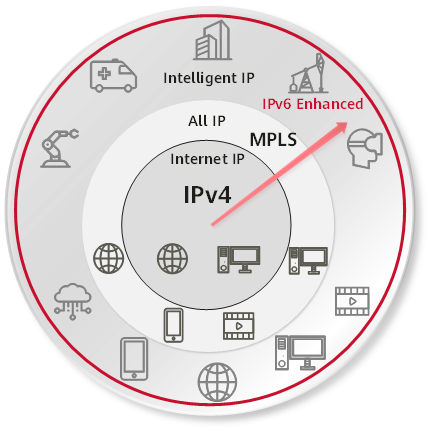
IP networks are moving towards the IPv6 Enhanced intelligent connection era
Key IPv6 Enhanced Technologies
IPv6 Enhanced builds on IPv6 to add intelligent identification and control. An IPv6 packet consists of three parts: an IPv6 basic header, one or more IPv6 extension headers, and an upper-layer PDU (payload). In IPv6, the Options field of the IPv4 header has been removed and multiple extension headers have been introduced. This improves packet processing efficiency, significantly enhances IPv6 flexibility, and provides better extensibility for the IP protocol. In an extension header, the Next Header field has the same function as that in a basic header and specifies the next extension header or upper-layer protocol type. Currently, many IPv6-based innovations are implemented by modifying extension headers without changing the IPv6 basic header. As such, IPv6 reachability can still be ensured. Moreover, an IPv6 extension header can be of any length and can theoretically be extended indefinitely, offering excellent flexibility and huge space for innovation.
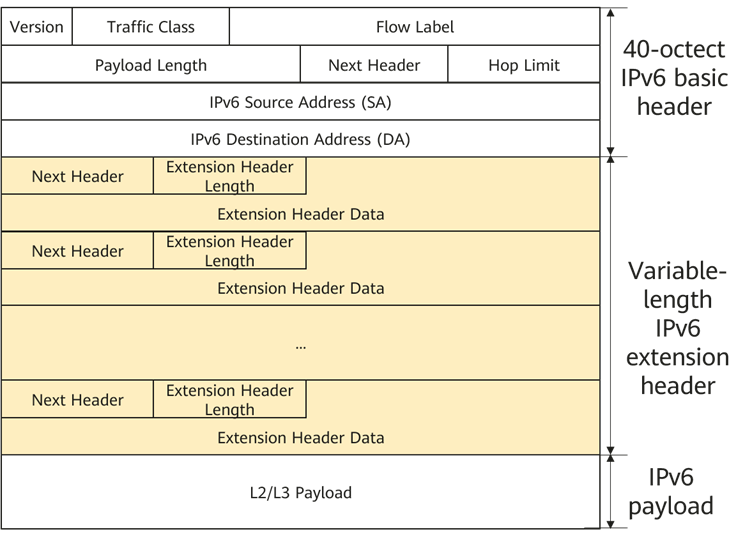
IPv6 packet structure
As defined in RFC 8200, IPv6 extension headers appear in the following order: Hop-by-Hop Options, Destination Options, Routing, Fragment, Authentication, Encapsulating Security Payload, Destination Options, and Upper-Layer headers. The Destination Options header occurs at most twice (once before the Routing header and once before the Upper-Layer header), and the other extension headers occur at most once. Currently, the design of the IPv6 extension headers has been successfully applied to technologies such as SRv6, network slicing, IFIT, BIERv6, and APN6. The industry refers to these as IPv6 Enhanced.
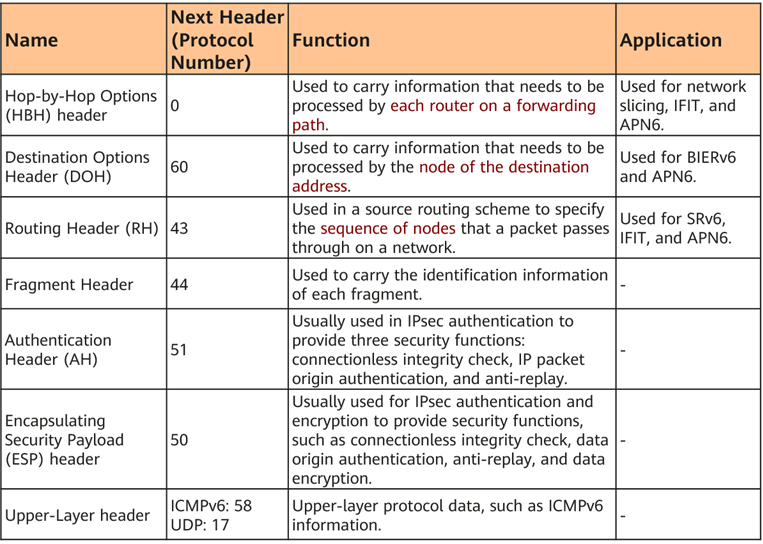
IPv6 extension headers
IPv6+SRv6: Simplified Protocols, E2E Cross-Domain Collaboration, and Ubiquitous Connectivity
SRv6 is a next-generation IP bearer protocol that simplifies the complex, traditional network protocols. In the 5G and cloud era, it serves as the foundation for building intelligent IP networks. SRv6 combines the advantages of the source routing mechanism used in Segment Routing (SR) with the simplicity and extensibility of IPv6. In addition, SRv6 provides multi-dimensional programming space and complies with the Software-defined Networking (SDN) paradigm, making it a powerful tool for implementing intent-driven networks.
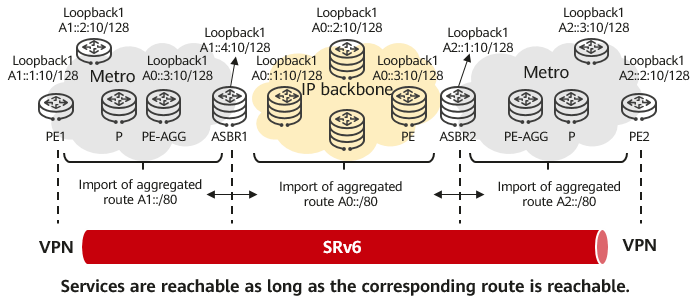
SRv6 large-scale networking
SRv6 brings the following benefits:
Simplified protocols: SRv6 simplifies protocols by eliminating the complex interaction among various protocols (IGP, BGP, LDP, RSVP-TE, and BGP_LU) and instead utilizing only the IGP and BGP. In addition to providing a unified forwarding plane for all services, SRv6 simplifies network modeling and O&M, laying a foundation for automation and intelligence.
Cloud-network interworking: SRv6 is based on IPv6, meaning that services are reachable as long as the corresponding IP routes are reachable. This ensures that new services can be quickly provisioned. Furthermore, SRv6 natively supports cross-domain scenarios, helping achieve any connectivity.
Unified management and control: Overlay and underlay networks can be either separated or combined. Because SRv6 leverages the source routing mechanism, transit nodes are unaware of tunnel states.
Application-driven: SRv6 can be fully combined with applications to enable intelligent connections.
For more information about SRv6, see What Is SRv6?.
IPv6+Network Slicing: One Network for Multiple Purposes, Meeting Deterministic Network Requirements of Thousands of Industries
Network slicing provides multiple logical networks (slices) on the same shared network infrastructure. Each slice serves a specific service type or industry user, as shown in the following figure. Each network slice can flexibly define its logical topology, SLA requirements, reliability, and security level to meet differentiated requirements of different services, industries, or users.

IPv6+network slicing application
Network slicing brings the following benefits:
Resource and security isolation: Slice resource reservation technologies are used to implement refined management of network resources, thereby meeting the differentiated SLA and network isolation requirements of vertical industries in the 5G era. In addition, security isolation is used to isolate the services of some private lines and private networks from other public services and ensure they exclusively use resources.
Deterministic latency: Deterministic and committed latency assurance can be achieved.
For more information about network slicing, see What Is Network Slicing?.
IPv6+IFIT: In-Band Flow Measurement, Enabling Service Experience Visualization and Manageability
In-situ Flow Information Telemetry (IFIT) marks real service flows on a network to directly measure network performance indicators such as the latency, packet loss rate, and jitter. As shown in the following figure, the ingress of a service flow colors packets, and timestamps are added to the packets on each hop of the service flow. After data is sent to the controller, the controller performs unified calculation and analysis to obtain information about the latency, jitter, packet loss rate, and more.
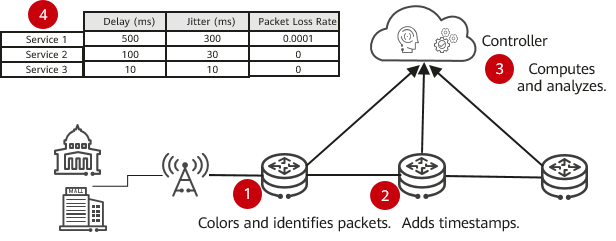
IFIT
IFIT brings the following benefits:
Real-time visualization: In-band flow measurement, data collection within seconds, and real-time display of service quality indicators such as packet loss rate and latency
1-minute demarcation: The SDN controller and IFIT hop-by-hop analysis enable automatic restoration of service paths, and the mass fault algorithm quickly identifies fault areas and accurately locates faulty ports and links.
Service self-healing: Based on the demarcation analysis result, the SDN controller delivers automatic adjustment policies to implement intelligent self-healing.
For more information about IFIT, see What Is IFIT?.
IPv6+BIERv6: Optimal Bearer Solution for Multicast Services in the IPv6 Era
BIERv6 uses the IPv6 extension header, IPv6 address reachability, and programmable space to implement the BIER multicast architecture in native IPv6 mode. BIERv6 provides better multicast deployment capabilities and can be extended to support subsequent native IPv6 features. In the inter-region multicast networking shown in the following figure, the ingress encapsulates the set of multicast receiver nodes as a BitString into the packet header before forwarding a packet. After receiving the packet, each transit node forwards it to the next node in stateless mode based on the address information contained in the packet header. This simplifies protocols and O&M because no additional multicast protocol is required and transit nodes do not need to maintain states for each multicast flow. In addition, convergence is not subject to the number of multicast flows, greatly improving user experience and reliability.
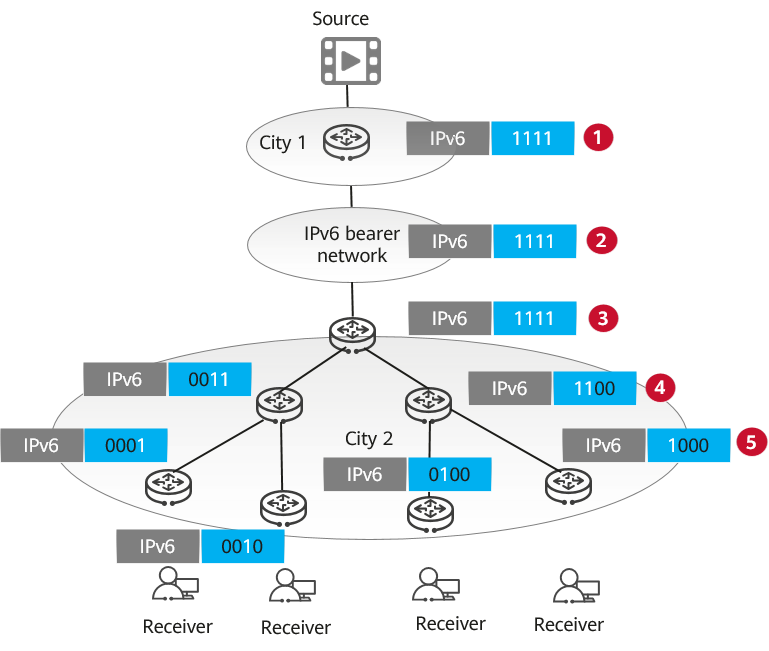
Inter-region multicast networking
BIERv6 brings the following benefits:
Simple configuration and easy inter-region service deployment: BIERv6 needs to be configured only on the ingress. Based on IPv6 encapsulation, inter-region multicast services can easily traverse BIERv6-incapable nodes and third-party networks.
Fast convergence and guaranteed experience: Transit nodes are unaware of services, and protocol convergence is fast (at the millisecond-level).
For more information about BIERv6, see What Is BIERv6?.
IPv6+APN6: Refined Network Operation Through Application-based Differentiated Channels
APN6 uses an IPv6 extension header to carry application information (including application ID and service requirement information) into the network. In this way, the network can be aware of the application and its requirements and provide it with SLA guarantee.

APN6
APN6 brings the following benefits:
Network identifies applications and applications drives the network: Traditional IP headers contain only basic information for route selection, and the service types carried by IP packets cannot be identified. APN6 uses the application information carried in an IPv6 extension header to notify the network of the services to be provided.
Stateless service chain, accelerating service innovation: APN6 implements application-level refined management and accelerates continuous innovation of new services.
IPv6 Enhanced Industry Progress
IPv6 is an inevitable trend for the upgrade and evolution of the Internet, an important direction of network technology innovation, and a foundation for the construction of a cyberpower. It is also a connection foundation for a digital China and a critical component in helping China deal with international Internet competition.
In November 2017, China issued the Action Plan for Advancing the Extensive Deployment of Internet Protocol Version 6 (IPv6) to comprehensively promote the development of the next-generation Internet based on IPv6, achieving China's progress from a "big Internet country" to a "powerful Internet country."
In 2019, China released the white paper China IPv6 Development Status and the National IPv6 Development and Monitoring Platform. In addition, a work group focusing on IPv6 Enhanced technology innovation was set up to specify the three-step development strategy for IPv6 Enhanced technology research and industry practice. The development of the IPv6 Enhanced technology innovation system is divided into three phases. The first phase is to provide partial programming capabilities for networks based on SRv6. The second phase is to implement autonomous networks that can conditionally ensure user experience. The third phase is to use application-driven network technologies to implement application-aware and highly autonomous networks — this is the ultimate goal of network development.

Three development phases of the IPv6 Enhanced technology innovation system
The three phases are detailed as follows:
- IPv6 Enhanced 1.0: mainly provides basic SRv6 features, including VPN, TE, and FRR. Because the three features are widely used on existing networks, SRv6 needs to inherit them and simplify network service deployment by leveraging its own strengths.
- IPv6 Enhanced 2.0: focuses on new features oriented towards 5G and cloud. These new features, such as IFIT, BIERv6, network slicing, and G-SRv6, and more, can be extended by introducing IPv6 extension headers.
- IPv6 Enhanced 3.0: focuses on APN6. As the main part of IPv6 Enhanced 3.0, APN6 further implements seamless combination of network capabilities and service requirements on the basis of IPv6 Enhanced 2.0 to form a highly autonomous network. The programming space of IPv6/SRv6 packets is used to carry application information into the network, thereby enabling the network to be aware of applications and their requirements and provide corresponding SLA guarantee.
In March 2021, the National People's Congress (NPC) approved the Outline of the People's Republic of China 14th Five-Year Plan for National Economic and Social Development and Long-Range Objectives for 2035, which proposed the task of "comprehensively promoting the commercial deployment of Internet Protocol version 6 (IPv6)" again.
In July 2021, China continuously released the Notice on Accelerating the Extensive Deployment and Application of Internet Protocol Version 6 (IPv6) (5 years), 3-Year Special Action Plan for IPv6 Traffic Improvement (2021-2023) (3 years), and Work Arrangement for In-depth Promotion of Large-Scale IPv6 Deployment and Application in 2021 (1 year), completing comprehensive 1-, 3-, and 5-year policy formulation.
It can be seen from this that the promotion and deployment of IPv6 has become a national strategy. "IPv6 Enhanced and next-generation Internet" has been incorporated into the top-level design of national standards and policies, and it is becoming a consensus on the evolution of the next-generation Internet.
IPv6 Enhanced technology innovation accelerates the application of IPv6 Enhanced technologies in various industries based on the large-scale IPv6 deployment progress in China. On top of this, IPv6 Enhanced fully releases IPv6 flexible openness capabilities, implements network upgrade, and promotes the improvement of next-generation Internet service capabilities. This provides a solid foundation for the digital development of thousands of industries and effectively promotes large-scale IPv6 deployment. Huawei will continue to strengthen its research in the IPv6 Enhanced technology innovation field to help China continuously lead the next-generation Internet innovation.
- Author: Liu Yan
- Updated on: 2022-04-29
- Views: 9022
- Average rating:







